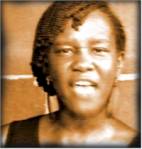LITR 5731: Seminar in American
Multicultural Literature (Immigrant)

Student Poetry Presentation summer 2006
Poetry
Presentation: Patricia
Smith “Blonde White Women” pg.
79
Date:
Tuesday, June 6, 2006
Poetry
Leader:
Carrie Arnett

Patricia Smith
(1955 to Present)
Biographical
information
Born in Chicago and educated in Illinois, Smith worked at the Chicago Sun
Times as a journalist. Soon after,
she moved to Boston to pursue her career in journalism. Patricia Smith is known for being a slam poet (where poetry is performed on stage and judged by the
audience). Patricia Smith is a four-time
National Poetry Slam champion.
Smith is a poet, playwright, author and teacher.
In 1998 she was nominated for a Pulitzer Prize in journalism, but
withdrew after controversy circulated about the validity of some of her work.
Afterward, Smith’s career suffered, as well as her personal life.
However, Smith’s life and work did eventually improve; and she
continues to perform her poetry today. Her
poetry speaks for those who have not been heard, and is delicious to both the
“eye and ear.”
http://www.english.uiuc.edu/maps/poets/s_z/p_smith/about.htm
“Blonde
White Women” Page
77-79
Objective 3
“The Color Code”
- This
piece focuses on the subject of skin color (pg. 77 “I remember striving
for that breathlessness…wishing myself golden.”)
- Western
culture transfers the values it associates with “light and dark”
- good
& evil (pg. 77 “Next to
me, / skinny pink fingers…shiver a bit under my scrutiny.”)
- clean
& dirty (pg. 78 “I
saw how much she wanted to wash.”)
- “snarling
madonnas” “curt dismissing glare”
Objective
3 :
Compare and contrast the immigrant narrative with the minority narrative,
or American Dream versus American Nightmare.
- The speaker
in this poem feels a sense of marginalization.
Since the “social contracts” of minorities and immigrants can be
different, it can be said that she feels limited and marginalized by the
dominant culture. The speaker has been culturally chained to the dominant
culture’s definition of beauty. As
a child, she ignorantly wanted to be beautiful and to be beautiful was to be
white. But now, as an adult,
she is not afraid to find her own definition of beauty: Patricia Ann.
She is proud of who she is, and realizes that her culture and
ethnicity make her the beautiful woman that she has become.
The poem portrays an African-American woman who struggles
inwardly with her outer appearance. She
is surrounded by external factors that seem to pressure her or suggest to her
that she should be something that she is not.
As she flips through her Ebony Magazine,
the products that are advertised connect to the dominant culture, and supply her
with a way to assimilate into this dominant culture: hair-straightening products
and bleaches for the skin. These
products produce traits that are common with white women.
These products also reinforce her belief that she is not accepted in this
white culture, causing her to remember her childhood dreams of wanting to be a
blonde, white woman. While reading
the poem, the reader is left wondering whether or not the narrator will accept
or resist assimilation by the end of the poem.
The narrator flashes back to her childhood where she creates her own ways
to become white: coloring her pictures “pink” and even going so far as to
color her actual skin with such force that she breaks the skin.
This little girl wants desperately to be white girl; trying not only
crayons, but mop-tops for hair, and white t-shirts as well.
A beautiful, perfect human being would be one who is white in her eyes.
However, when her “blonde” teacher hugs her, the
narrator soon sees through those “blue eyes” for what they really are: not
genuine. As she becomes an adult,
her perception of herself changes. She
becomes proud of who she is and realizes that she is
beautiful. She no longer idealizes
the blonde white woman, and there is a moment of self-empowerment, producing a
positive outcome from a heartbreaking story.
Discussion
Questions:
- Do
you feel the narrator resists the dominant culture
or assimilates at the end of the poem?
- Why
does the poet portray the women at the end of the poem, as “snarling
madonnas?”
|
|
|
|


